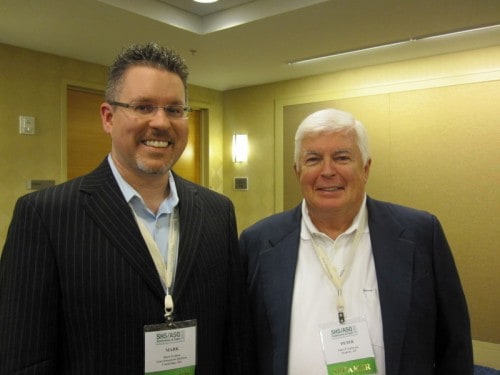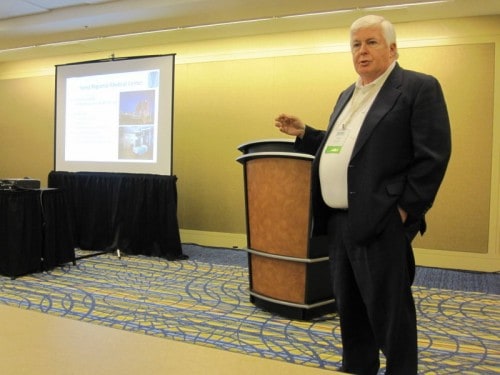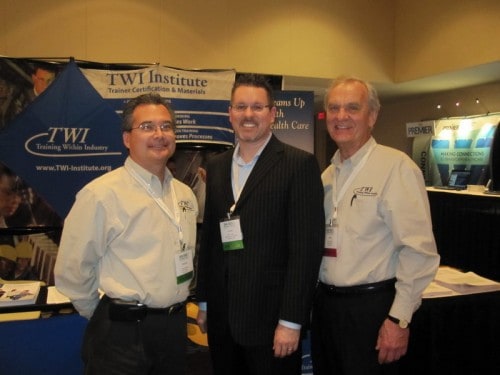On Friday, I co-presented at the Society for Health Systems / ASQ Healthcare Division conference in Atlanta. It was the first time this was done jointly and it seemed we had more physicians and other clinical people around, which is great. I presented with Dr. Peter Patterson, a pathologist from Arizona. Our topic was the use of the Training Within Industry program in healthcare, including a case study from a lab in Yuma.
Here's a shot of us after our talk:

I gave the first part of the talk, which included some historical context of where TWI started (as a U.S. government program in WWII) and how it became a core part of the Toyota Production System. I also talked about how it was applied to healthcare during the war, citing journal articles that were related to nursing and other hospital processes.
Some links and references for those who attended, or in general:
- I wrote about TWI and the 31 problems in healthcare from 1944 in this TWI Institute article.
- Fuller reference is : United States, Hospital Adaptation for the Job Instruction Manual, August 1944, Subgroup 211.22.3 General Records of the Training Within Industry Service, Records of the War Manpower Commission (WMC), Record Group 211, National Archives Building, Washington, DC.
- 1944 American Journal of Nursing article “We Cannot Afford to Hurry” (link no longer available)
- WWII TWI Healthcare Manuals – Job Instruction
- Article on Job Methods: WASTED HOURS, Hospitals 1943
- Tebbetts article on lean / TWI methods and cosmetic surgery
Dr. Patterson gave an impressive case study about improving quality through TWI Job Instruction methods in a histopathology lab:
Dr. Patterson told the story of how the lab went through six different people in three years in a specimen receiving and processing role. Error rates were high and employees either left out of frustration or got let go. In a traditional management mindset, the lab lamented that they couldn't find good people (or so they thought).
Having discovered TWI, for the 7th employee, they created a formal Job Instruction document and used it to train the employee in the formal 4-step TWI approach:
- Prepare the worker
- Present the operation
- Try out their performance
- Follow up their work
This is a practical, hands-on, on-the-job training approach that's far better than just telling people verbally what to do or making them just read thick SOP manuals.
This chart shows how quality improved dramatically. The 7th person is still working. They are now working on figuring out how to achieve a true “zero defects” process.
 Impressive results, all through pretty basic methods. Amazing work! The defect rate fell from 33.5% to just 2.6%. That's still too high, but it's far better than before. Defects included things like administrative errors (omitted one of the physician's names) or clinical errors (incorrect name on specimen).
Impressive results, all through pretty basic methods. Amazing work! The defect rate fell from 33.5% to just 2.6%. That's still too high, but it's far better than before. Defects included things like administrative errors (omitted one of the physician's names) or clinical errors (incorrect name on specimen).
TWI was also being used in the context of a fuller Lean implementation that also had a large focus on staff engagement and “respect for people.”
Here are our slides via slideshare.net:
At the conference, I finally met Bob Wrona and Patrick Graupp from the TWI Institute. They are authors of the outstanding book The TWI Workbook: Essential Skills for Supervisors (with CD). I've recommended this book to many hospitals and I'm glad to have finally met them in person:
Do you have examples or success stories of your own related to the TWI methodology?
Please scroll down (or click) to post a comment. Connect with me on LinkedIn.
Let’s build a culture of continuous improvement and psychological safety—together. If you're a leader aiming for lasting change (not just more projects), I help organizations:
- Engage people at all levels in sustainable improvement
- Shift from fear of mistakes to learning from them
- Apply Lean thinking in practical, people-centered ways
Interested in coaching or a keynote talk? Let’s talk.
Join me for a Lean Healthcare Accelerator Trip to Japan! Learn More












Mark (and Dr. Patterson),
Congratulations on the great presentation and thanks for the suggested resources. I’m working with a lab at this time which could benefit from these strategies. I will keep you posted about their success (which I am sure will follow).
Mike
.-= Mike Stoecklein ´s last blog ..A Tale of Two Cities (Labs) =-.
Mark,
Thanks for the great information.
Parastoo
[…] Society for Health Systems Talk on TWI dal Lean Blog di Mark Graban: TWI e sanità : casi studio ed esempi (traduzione automatica) […]
[…] might remember from back in March, when I co-presented at the Society for Health Systems conference about the use of the “Training Withi… methodology in […]
[…] Podcast #104 is a discussion with Dr. Peter Patterson (@IDrPete), a friend of mine and the Lean Blog the past few years. He wrote a guest post for me back in 2009 (A Breakthrough in Training – Call it “Near-TWI”) and I blogged about our presentation at the 2010 Society for Health Systems conference about Lean and TWI …. […]
[…] last year, when I presented, I’m attending as the Chair for the Patient Flow Track. Hope to see you there! I might also […]
Comments are closed.